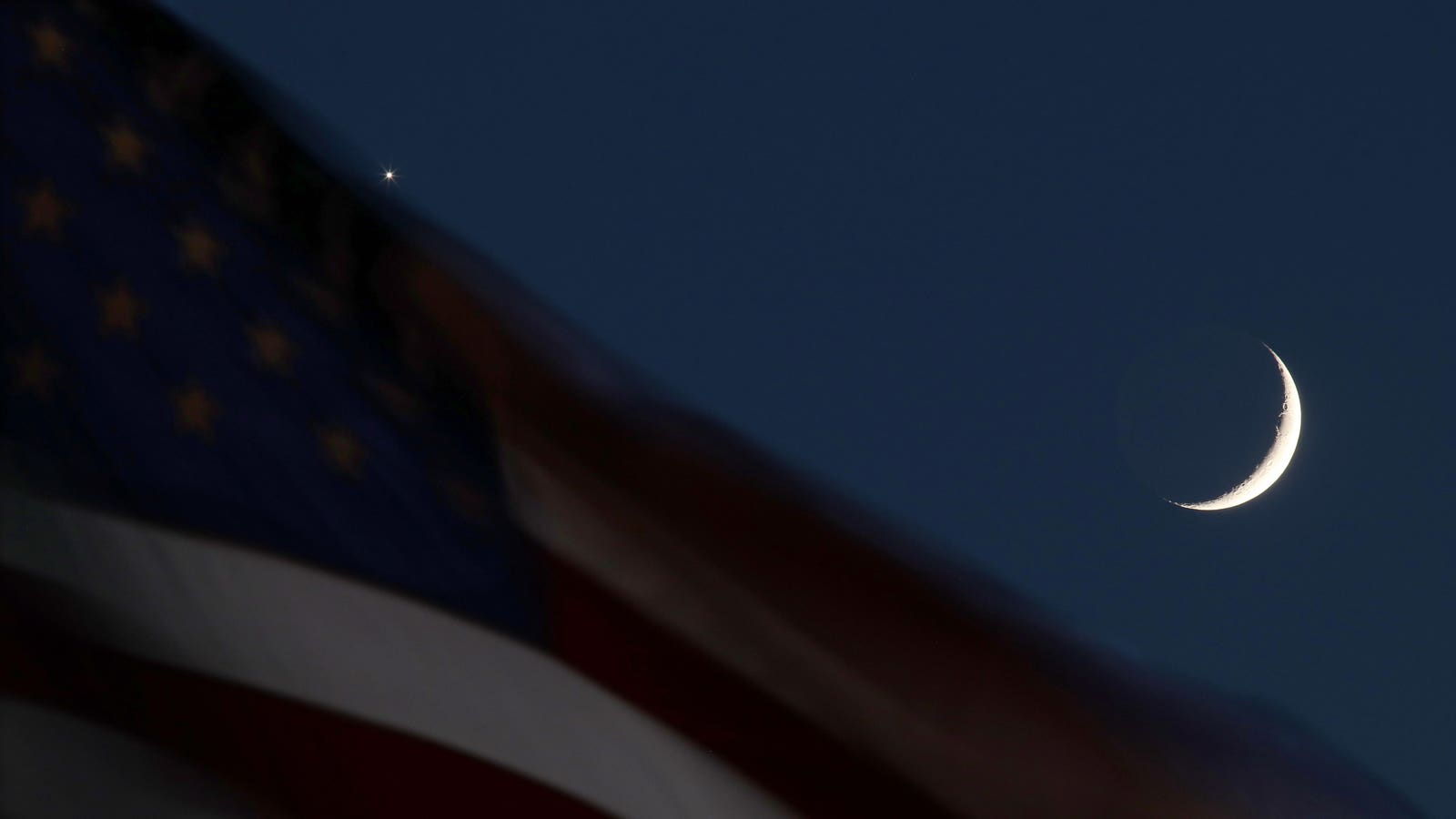Topline
Thursday, Aug. 21, offers a final chance for early-rising skywatchers to glimpse this week’s spectacular “planet parade.” On display since the weekend, the match-up of the crescent moon with Mercury, Venus, Jupiter and Saturn — as well as Neptune and Uranus (though not visible to the naked eye) — reaches its end with a final flourish. Although it may be challenging to see, a very slender crescent moon will shine close to Mercury, with a stunning star cluster visible between the two.
From Aug. 17–21, a spectacular “planet parade” (also called an alignment) features the moon and six planets. (Photo by Gary Hershorn/Getty Images)
Getty Images
Key Facts
On Thursday, Aug. 21, a 4%-lit waning crescent moon will shine just above Mercury low in the eastern sky about an hour before sunrise.
Just above Mercury will be the Beehive Cluster, an open star cluster of stars in the constellation Cancer.
Above the trio, Venus will be the brightest planet, with Jupiter, just above it, the next brightest.
Saturn will be visible in the southern sky. It’s now close to its annual bright “opposition” on Sept. 21, when Earth will be between Saturn and the sun.
Skywatchers wanting to see the moon and Mercury will need a clear view of the eastern horizon and a pair of binoculars (though stop using them well before sunrise).
The next “planet parade” isn’t until October 2028, when five planets will be visible together before sunrise.
Thursday, August 21: Moon, Mercury And the Beehive Cluster
Stellarium
Mercury And The Beehive Cluster
Mercury is notoriously tricky to see, but this week has seen it rise unusually far from the sun from Earth’s point of view. Just 36 million miles (58 million kilometers) from the sun — less than half Earth’s distance — it rarely strays far from the horizon. Nicknamed the “Swift Planet” for its speedy orbit, Mercury completes a trip around the sun in just 88 Earth days. The Beehive Cluster (M44) is one of the nearest open clusters to Earth and is about 580 light-years distant. The best way to see it in light-polluted cities is to use binoculars, through which you’ll see about 60 stars, though it could be tricky in the pre-dawn light.
August’s ‘black Moon’ And The Milky Way
Although it’s the “planet parade” that has stargazers excited this week, Saturday, Aug. 23, will see a seasonal “black moon,” the third new moon in a season of four. It means moonless night skies ideal for stargazing and some of the best views of the year of the Milky Way for observers in the Northern Hemisphere. Its arc of millions of stars can be seen pouring through the Summer Triangle stars high in the southeast and down to the constellations Sagittarius and Scorpius in the south. Use a light pollution map or stay in an International Dark Sky Place to get the best view.
Night Sky Mountain Lake and Milky Way Galaxy – Scenic view at night with clear skies and no light polution. Flat Tops Wilderness, Colorado USA.
getty
What’s Next In The Night Sky
After this week’s “planet parade,” only Saturn, Jupiter and Venus will be visible to the naked eye as Mercury sinks into the glare of the sun once again. Next month, there’s a total lunar eclipse on Sept. 7 for those in Asia, Africa and western Australia, a stunning view of a waning crescent moon, Venus and bright star Regulus on Sept. 19, and a partial solar eclipse on Sept. 21 for the Pacific Ocean. Saturn will also reach its annual “opposition” on Sept. 21, which is the best time to see its rings — though you will need a backyard telescope.
Tangent
Thursday, Aug. 21, is also the eighth anniversary of the “Great American Eclipse,” a coast-to-coast total solar eclipse seen by around 12 million people in 12 U.S. states. The first total solar eclipse visible across the U.S. in 99 years, the 80 miles-wide moon’s shadow brought totality as long as 2 minutes and 20 seconds to Oregon, Idaho, Wyoming, Nebraska, Kansas, Missouri, Illinois, Kentucky, Tennessee, Georgia, North Carolina and South Carolina.
Further Reading
Forbes‘Planet Parade’ Myths Debunked And How To Truly See It — By A StargazerBy Jamie CarterForbesYour Ultimate Guide To Meteor Showers And The Perseids — By An ExpertBy Jamie CarterForbesNASA Urges Public To Leave The City As Milky Way Appears — 15 Places To GoBy Jamie Carter












